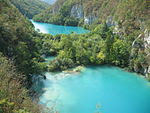Croatia officially the Republic of Croatia is a unitary democratic parliamentary republic in Europe at the crossroads of Central Europe, the Balkans, and the Mediterranean. Its capital and largest city is Zagreb. The country is divided into 20 counties and the city of Zagreb. Croatia covers 56,594 square kilometers (21,851 square miles) and has diverse, mostly continental and Mediterranean climates. Croatia's Adriatic Sea coast contains more than a thousand islands. The country's population is 4.29 million, most of whom are Croats, with the most common religious denomination being Roman Catholicism.
Over time, water has flowed over the natural limestone and chalk, creating natural dams which in turn have created a series of connecting lakes, waterfalls, and caves. The nearby forests are home to bears, wolves and many rare bird species.
Historical Complex of Split with the Palace of Diocletian
The palace was built by the Roman emperor Diocletian
at the turn of the 4th century AD, and later served as the basis of the
city of Split. A cathedral was built in the Middle Ages inside the
ancient mausoleum, along with churches, fortifications, Gothic and
Renaissance palaces. The Baroque style makes up the rest of the area.
Old City of Dubrovnik
Dubrovnik became a prosperous Maritime Republic during the Middle Ages, it became the only eastern Adriatic city-state to rival Venice. Supported by its wealth and skilled diplomacy, the city achieved a remarkable level of development, particularly during the 15th and 16th centuries.
The Stari Grad Plain is an agricultural landscape that was set up by the ancient Greek colonists
in the 4th century BC, and remains in use today. The plain is by and
large still in its original form. The ancient layout has been preserved
by careful maintenance of the stone walls over 2,400 years.
Historic city of Trogir
Trogir's rich culture was created under the influence of old Greeks, Romans, and Venetians. It is the best-preserved Romanesque-Gothic complex not only in the Adriatic, but in all of Central Europe. Trogir's medieval
core, surrounded by walls, comprises a preserved castle and tower and a
series of dwellings and palaces from the Romanesque, Gothic,
Renaissance and Baroque periods.






No comments:
Post a Comment